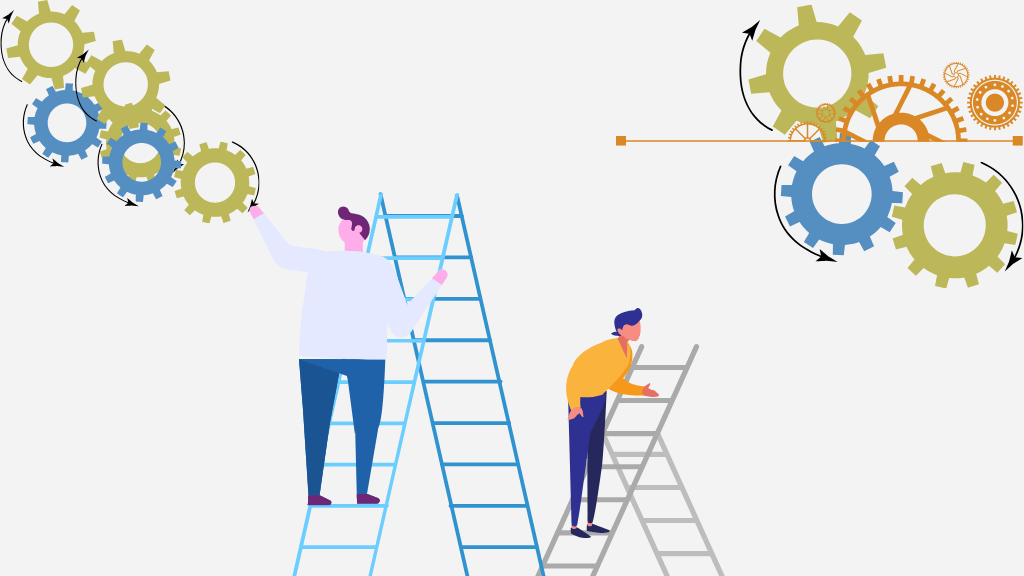Two tech heroes are making a big splash: IoT, which stands for Internet of Things, and ERP, commonly known as Enterprise Resource Planning. Consider IoT as a collection of smart devices and sensors that are spread across your farm.
These devices will be monitoring things like soil moisture, plant health, and weather conditions 24/7. Through these tools, you can get updates on your computer or smartphone while the real-time pulse of your farm is sending live feed.
However, on the other hand, the ERP software can be seen as the brain of your farm. It is a tool that assists you in managing the whole range of things from inventory and purchasing to planning and finance, all in one place.
The ERP system is the source of the powerful dashboard which is fed with the data from your IoT devices on the farm. The dashboard not only tells you what is happening on your farm right now but also helps you make smart decisions for the future.
However, what is the reason that the combination makes it the groundbreaking technology in the field of farming?
It is in this context that precision farming becomes relevant. This is farming of the future, where you will learn to make choices that will increase the yield, lower the wastage and make the environment healthy.
As is indicated in a study done by the American Society of Agricultural and Biological Engineers, Erp for precision agriculture can bring yield increases of up to 67%. At the same time reduce the environmental impact of farming.
IoT in Agriculture!
Initially, IoT in farming is based on the utilization of a few devices with sensors that are deployed all over the farm. It is not the kind of gadget you would expect. They are the farm’s eyes and ears, constantly monitoring the moisture of the soil and how much light the crops get. Moreover this technology is such that you can get data from everywhere in your farm and it connects all information through the internet.
Examples of IoT use in monitoring and controlling agricultural environments:
1. Soil Moisture Sensors
These devices can help you know whether your soil is wet or not and accordingly decide the right time for watering the crops. This is especially beneficial as it will reduce the amount of water you use, as well as ensure that your plants get the specific amount of water that they require.
2. Weather Stations
This is vital because you will know with certainty the real time microclimate of your farm after you set up the weather station. It also aids in the good scheduling of planting and harvesting times.
3. Drones
Drones are capable of flying over your farm and taking aerial shots of the crops, so you can see the whole farm from the bird’s eye view and identify any areas that require your attention. By doing this you can early identify problems and solve them before the process is ruined.
Understanding ERP in Agriculture
Simple definition of ERP software
The ERP is the perfect tool designed to keep your farm under control. It is a system that helps you in the monitoring of all the business aspects such as finances, inventory, operations and customer relationships under one roof. Think of it as a virtual command headquarters that gives you a comprehensive view of the business side of your farm.
How ERP supports farm management and decision-making?
The usage of renewable energy resources has been increasing in recent years as people become more conscious of the environmental impact of fossil fuels.
1. Data-Driven Decisions
This is because ERP systems provide you with all your operational data in one place and this helps you in having a better insight of the situation and you are able to make informed decisions. It assists in determining whether a particular type of crop is more profitable or managing your supply chain more effectively, whatever it is, ERP is the solution to your problem.
2. Streamlining Operations
ERP will help you to run the farm in a structured way and to make sure that the daily tasks are performed in an organized manner. It has a schedule for employees and it helps to organize resources as a result it reduces confusion and ensures that everything is properly organized.
3. Financial Management
To be honest, it is a really hard thing to manage finances of the farm. ERP systems make this task a walk in the park by tracking your expenditures, revenues and profits, enabling you to be more in control of your financial health.
The combination of IoT’s real-time monitoring and management capabilities of ERP allows the farmers to be aware of the latest developments. It also to make data-driven decisions to improve their processes and output. This integration is yet another step towards the use of technology in farming to make it more efficient and productive.
The Synergy of IoT and ERP
1. Real-time data collection and analysis
IoT devices help you monitor all the activities happening on your farm. They send you alerts on the soil moisture levels and crop health. These data are directly linked to your ERP system so you can have an analysis in real-time. Therefore you can get the insights you need immediately not after weeks.
2. Improved decision-making and efficiency in farm operations
Imagine a scenario of you being able to water your crops precisely when you want and knowing the health of your livestock anytime. IoT and ERP jointly offer you the privilege of not just guessing, you know. This will ensure the decisions made are smarter and farm management is more efficient.
3. Cost savings and reduced waste:
By having a close watch on the needs of your farm, you can be more effective in the use of resources such as water and fertilizer, and so, waste can be reduced. Besides, the skill of making better decisions is going to allow you to avoid unnecessary expenses in the future and thus you can have more money in your bank account.
Efficient Strategies for Integrating IoT and ERP

1. Starting with what you need
Step one is to come up with the challenges you are facing on your farm. Do you need to have the crop monitoring, livestock management or resource tracking updated? Stating the specific needs will make it easier for you to settle with the right technology that is fit for you.
2. Choosing the right tools
Not all IoT devices and ERP systems are produced with the same quality standards. To begin with, you should get hold of the devices that can easily be connected with the ERP software. Discover the compatibility and make certain that the technology is suitable for your farm size and needs.
3. Integration process
This is the basic process that you have to follow for connecting your IoT devices to an ERP system:
a. Installation and setup
Firstly, put the IoT devices in the farm where it is necessary. This could be accomplished by using soil sensors, weather stations, and livestock health monitors, for example.
b. Connecting devices to the network
Ensure that every device on the network is able to send data. This link can be a Wi-Fi, cellular, or other kind of connection.
c. Feeding data into your ERP
The next step is to link your devices and then to verify that the data feeds into the ERP system. This would most likely need some tech configuration, so it might be a good idea to consult a tech expert on that.
d. Analysis and action
When the system is fed with the data, the analysis tools of the ERP should be used to get the right information on your farm. Although the first step of collecting data is sometimes tough and time-consuming, you will eventually understand how to use this data to enhance business operations.
Farmers can enjoy higher productivity and efficiency by simply following the procedure and considering the benefits of the IoT and ERP integration. They can become the leaders of a sustainable and profitable agriculture of the future.
Challenges and Solutions

The integration of IoT with ERP farming systems may be a game-changer, but it has some drawbacks as well. Here’s how to navigate common obstacles:Check out the following ways to overcome the most common challenges:
1. Technical Issues and Compatibility
The most common cause of data inconsistency between IoT devices and ERP systems is the technical incompatibility problem.
Solution: List down the IoT devices and ERP software that are compatible or that offer efficient integration. Getting a discussion with technology providers before purchasing will help you to avoid the pain that comes with buying the wrong product.
2. Data Overload
The volume of data collected is so huge that the process of finding applicable insights can be a challenge.
Solution: Utilize ERP systems that are equipped with advanced data analysis capabilities. Ensure that you have a specific purpose of the data that you want to get from the dashboard. For this purpose you can modify its design to highlight the important metrics.
3. Cost Concerns
The first cost of technology can be high, especially for small-scale farms.
Solution: Commence with a small scale, focusing on the most urgent areas where IoT can have a significant impact. Try to find scalable solutions that can help you to have more devices or features when you have the budget.
4. Technical Skill Gaps
You don’t have to be a genius in technology to use new systems, but it may be very scary.
Solution: First and foremost, make sure to choose systems that have intuitive features and excellent customer support. Majority of the providers deliver skill development courses. Just as you should seek to recruit a technology-savvy person or a consultant who can help you with the digital gap, so should you.
Tips for Smooth Implementation
1. Plan Carefully
It is advisable to have a well-developed plan before you start. The plan will include your objectives, the technology required, and the integration steps.
2. Engage Your Team
Make sure that all those who will take part in the process know about the benefits of the system and how it works. Training and continuous support constitute the essential components.
3. Start Small and Scale
The first step is to launch a pilot project. This is the best way for you to make the necessary changes and to learn before making the ultimate decision.
Looking Ahead!
The future of farming with IoT and ERP is positive and promising. Predictions include:
a. Automated and Precision Farming
Technology will provide more automation and accuracy which in turn will lead to more yield and less waste.
b. Sustainable Practices
IoT and ERP will be the main elements in the better farming. They will allow to manage the resources effectively and minimize the environmental impact.
c. Data-Driven Agriculture
The future will definitely involve more data-based decision making with AI and machine learning. Hence being the ones to offer insights that are beyond human analysis.
Conclusion
The introduction of IoT into ERP is not only a trend; it is a revolutionary transformation. It has great gains for the agricultural sector. However, the challenges are not impossible to address. Through purposeful planning, proper tools, and the ability to adapt the farmers can drastically improve their production to a higher level.
Let’s invite all the agricultural industry players to think how this integration can meet their farming needs and create a future where farming is more productive, sustainable and efficient. The sky is the limit and now is the time to begin.




